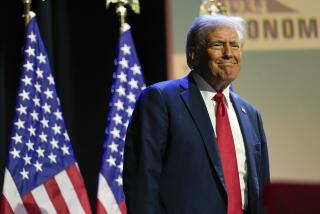Can Perot Buy His Way to White House? : Politics: He offers the ultimate test of whether a well-heeled candidate can win the presidency solely with a TV ad blitz. Most experts doubt it.
- Share via
DALLAS — Since the dawn of the media age, pundits and political scientists have toyed with the intriguing question of whether a well-heeled, unconventional candidate could gain the presidency with a multimillion-dollar television advertising blitz.
Today, that is no longer an idle question.
Over the next week, Ross Perot will spend an unprecedented sum of money on television advertising--$5 million a day, by some estimates--in his long-shot bid to defeat President Bush and Democratic challenger Bill Clinton. In essence, Perot is providing the ultimate test of the power of television and the potency of political advertising to change the course of American history.
If anyone can do it, his aides contend, it is the Texas businessman. “There is nothing more powerful than Ross Perot looking right in the camera and talking to you,” said Sharon Holman, his press secretary.
But despite the unique power of political advertising in the last few decades, most experts maintain that Perot cannot succeed in winning the presidency with television advertising alone, no matter how much money he spends.
While his 30-minute, prerecorded commercials have achieved higher ratings than expected and his shorter ads have been praised for their polish and persuasiveness, political professionals contend that these programs are still just a curiosity to most viewers. Moreover, they predict that the novelty of Perot’s chart-thumping presentations is beginning to wear off.
It is also an open question in the minds of many observers whether even the best television commercials could overcome the barrage of negative publicity that Perot has received in the last few days as a result of his charges that he was targeted for a “dirty tricks” campaign by the Republicans.
“I don’t think Ross Perot is going anywhere,” said Michael Robinson, a political scientist who monitors the impact of television. “I don’t care how much money he spends; I don’t care how many ads he puts on the air.”
Since he re-entered the presidential race Oct.1, Perot has generally avoided the stuff of traditional campaigns--rallies, stump speeches, glad-handing. Instead, he has spent his time inside a television studio, taping dozens of commercials under the supervision of a specially organized group of professional advertising specialists known as Group 270.
Perot’s first 30-minute commercials were appealing for their unconventional simplicity. He was filmed sitting at a desk with hand-held charts, using a pointer and discussing the nation’s economic problems in simple, folksy language that drew millions of viewers.
After these ads aired, the Smithsonian Institution called Perot, asking him to donate his pointer and charts when the election is over.
Perot has since produced a variety of other ads, including 30-minute spots discussing his life and family, as well as many 30-second and 60-second ads focusing on particular national problems. They are so polished that even his former campaign director, Edward J. Rollins, who resigned in a dispute with Perot over the campaign’s advertising budget last July, calls them “the best on the air.”
Audience reaction to Perot’s ads have been overwhelmingly positive, too. Even the 30-minute ad with the narrowest appeal, in which Perot described from his own experience how to build a business, drew about 12 million viewers on Monday night.
The success of these ads has astounded the experts. Peter Fenn, a well-known media consultant in Washington, D.C., joked that if more political candidates decide to adopt this strategy, “it would put the Sominex people out of business.”
But Fenn said that Perot has succeeded in tapping into an unusually keen interest among voters this year in understanding the causes of the country’s economic troubles. He said Perot’s skillful, good-humored performance in the presidential debates also left many voters wanting to hear more of the Texan’s views.
“The public was ready for this newfound form of political entertainment,” said Fenn.
Television viewers have also been motivated by what Rollins calls “the curiosity factor.” Even those who support Bush or Clinton are intrigued by the activities of this self-made billionaire and unique political phenomenon.
Hoping to capitalize upon his advertising successes, Perot has purchased an expensive schedule of network air time over the next six days to broadcast some of his old ads, as well as some new spots. On Monday night, his half-hour ads will air on the three major networks.
Perot, who has acknowledged that he will spend more than $60 million from his own pocket on this race, has declined to disclose precisely how much the last-minute media blitz is costing him. But it has been estimated that perhaps as much as half of his total investment will be spent on the last wave of commercials.
Ironically, according to the experts, the more advertising Perot airs, the less impact each spot likely has on the voting public. As Americans become familiar with Perot and his views, the curiosity factor starts to diminish.
More to Read
Get the L.A. Times Politics newsletter
Deeply reported insights into legislation, politics and policy from Sacramento, Washington and beyond. In your inbox three times per week.
You may occasionally receive promotional content from the Los Angeles Times.










